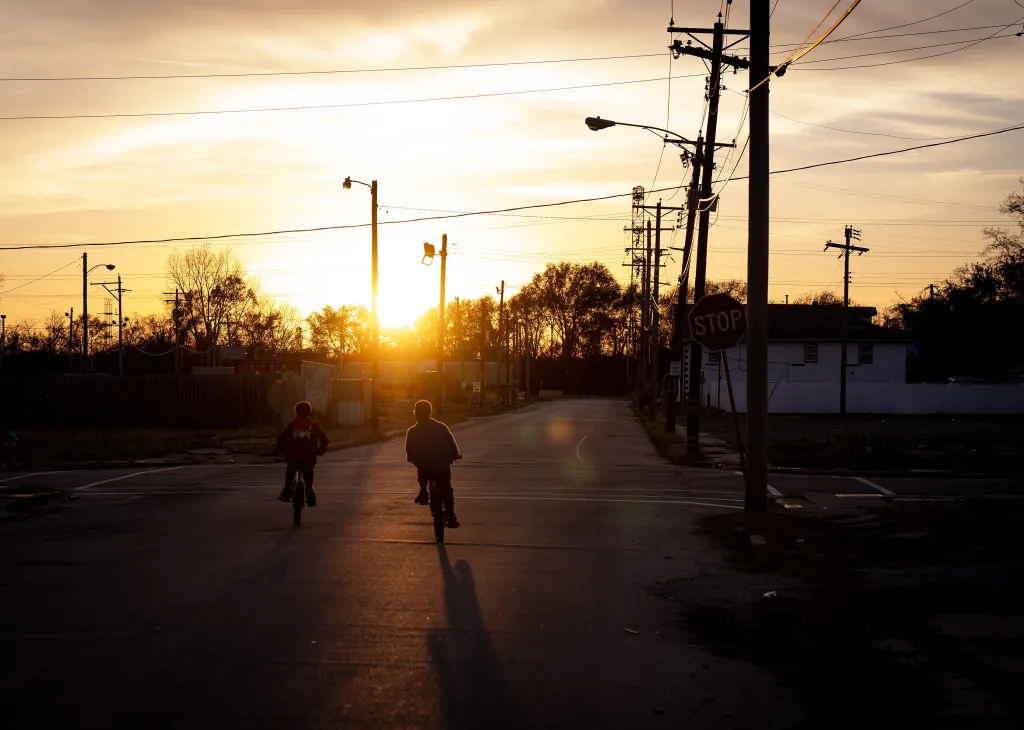
BROOKLYN, Ill. — The brick building at Madison and South 5th streets is still vacant, still boarded up, still tagged with faded gang graffiti.
For the second time in as many years, it’s been slated for a $2.5 million makeover, courtesy of the federal government, that would transform the building — once a grocery store and, later, a skating rink — into a community center for this historic town of 650 people across the Mississippi River from St. Louis.
And once again, the project has stalled, its future uncertain, amid partisan spending battles in Washington, D.C., and the looming threat of a government shutdown.
“This is a good example of an important community project being held hostage,” said U.S. Rep. Nikki Budzinski, a Springfield Democrat whose district covers Brooklyn and who included the community center as part of her federal appropriations requests in fiscal years 2025 and 2026.
“These communities, and Brooklyn is a great example, are not flush with cash,” she added. “They’re in need of these federal investments (and) the level of uncertainty is creating anxiety.”
There have been plenty of reasons for anxiety, and some signs of hope, in Brooklyn this year as community members and supporters fight to stave off the city’s demise and preserve its legacy as America’s oldest Black town.
In January, the Chicago Tribune profiled Brooklyn: Its founding in the early 1830s as a refuge for free and enslaved Black people. Its days as a thriving entertainment hub. Its eventual decline in the second half of the 20th century and the disparate group of archaeologists, urban planners, preservationists, current residents and former Brooklynites at the center of an ambitious revitalization plan.
Shortly after the story published, staff from U.S. Sen. Dick Durbin’s office contacted Brooklyn officials to offer federal help. People familiar with those discussions said they included the possible construction of a dual visitor center and museum, but excitement for the plan had been quashed a few months later when it became clear that President Donald Trump’s administration had little appetite for anything that spoke to the country’s history of racism.
A spokesperson for Durbin blamed the Trump administration and congressional Republicans for stymying federal investment in Brooklyn and other Illinois communities, saying their “historic cuts to Medicaid, education and other critical services have also impacted funding for local projects across the country, all to line the pockets of billionaires.”
‘We’ll be ready’
Mayor Trenton Atkins said he is not waiting around for the federal government, nor is he concerned with attempts to whitewash his hometown’s story.
“You can’t erase history,” he said. “It was here before we were, so how can you erase it? We’re going to always have our history in Brooklyn. I think they’re trying to keep our children from learning our history. But it’s up to us to step in and show them.”
Five months ago, the 65-year-old Brooklyn native and former village trustee unseated three-term incumbent Vera Glasper-Banks to become mayor. He’s called the availability of federal dollars a “freeze,” one he expects will eventually thaw.
“We’re trying to put ourselves in a position where when things get better,” he said, “we’ll be ready.”
And so, on a Monday in August, the new mayor boarded a golf cart and toured Brooklyn with a group that included state Sen. Christopher Belt of Swansea and representatives from Norfolk Southern railroad.
Generations of Brooklynites have been wary of continued expansion by the railroad companies whose tracks encircle the village and who, in past decades, have become its largest landowners in combined acreage and parcels.
Atkins, though, has tried to strike a different tone.
“The railroad has been here for years,” he said. “And what people don’t understand — the railroad is part of our history.”
Days after Norfolk Southern’s visit, he hosted a similar tour with officials from the Terminal Railroad Association of St. Louis. In both cases, he said the companies agreed to clear overgrown and littered lots they own in town. At least a dozen parcels were identified to start, he said, with the ultimate goal of redeveloping the properties.
Spokespeople from both companies confirmed the cleanup efforts have started on select parcels and that the companies are working with the village on economic development opportunities for the land.
“I just feel like Brooklyn has been behind the times for so long,” Atkins said. “Right now, I’m feeling good about it, because we’re getting key stakeholders at the table to talk about how we can change things. … I’m kind of excited to see down the line, like next year, where will we be?”
The mayor said he thinks one of the newly cleared parcels could become the site of a new fire station and village hall; the former has been condemned, the latter in not-much-better shape.
There are plenty of other needs in Brooklyn: Housing. Infrastructure repairs. Jobs and businesses so the village is less economically reliant on the adult entertainment industry, which had been booming but has retracted in recent years.
Before that can happen, though, Atkins said he wants the village to have a clear direction for its future. Helping with that effort is the Chicago-based nonprofit Far South Community Development Corp., which works primarily with communities on the city’s South Side.
Prompted by the Tribune’s coverage of Brooklyn, the organization’s president, Abraham Lacy, said he reached out to Brooklyn’s past administration about volunteering its services.
“I’m amazed as an African American and a person who’s pretty astute on history how I didn’t even know about this,” Lacy said. “I just felt a certain level of wanting, a need, to help. I came down there to say, however which way they want to use us, we want to do it.”
Lacy said he and other volunteers — consultants and urban planners — are in the early stages of research for what could ultimately become a comprehensive village plan, one that incorporates and builds upon last year’s revitalization planning sessions organized by the Western Illinois University-based Illinois Institute for Rural Affairs.
The Trump administration’s posture toward Black history — and the ensuing effects on federal funding allocations — is not deterring that work, Lacy said.
“I don’t think we should give much weight to this administration because they’re a moment in time,” he said. “Although they could delay things from happening, they can’t deny us because, eventually, we’re going to get what we need.”
Illinois, he added, is “a state that invests in people and invests in communities.”
‘A homegrown archaeologist’
While federal grant dollars have, for now, seemingly vanished, Brooklyn has been the recent beneficiary of outside investments.
In July, the National Trust for Historic Preservation awarded a $50,000 grant to the Illinois State Archaeological Survey. The money will help the University of Illinois-based research team partner with the Historical Society of Brooklyn, Illinois to continue excavating sites in search of additional artifacts from the town’s beginnings — evidence they hope will bolster Brooklyn’s eventual inclusion on the National Register of Historic Places.
The grant will also fund an afterschool program, focused on archaeology and local history, in the village’s school district as well as an archaeology internship for one local high school student.
“We’re hoping this could lead to a homegrown archeologist,” said Erin Benson, one of the state archaeologists in charge of the grant.
State archaeological survey staffers are also working on separate projects to garner more historic recognition for Brooklyn. One involves making sure Brooklyn is no longer excluded from maps and literature documenting the path of Route 66 — the venerable road once passed through town and is celebrating its centennial next year.
The other involves applying to have Brooklyn’s Civic Center building added to the national register. Built in 1952, the building once hosted talent shows, dances, weddings, funerals and baby showers. Today, it’s been largely replaced as a community gathering spot by the nearby senior center, though it’s still used for some smaller events.
“People called it the heartbeat of the community,” said Laura Shih, an ISAS architectural historian who is working on the national register application. “There’s been so much done in Brooklyn as far as its founding.” But, she added, “there’s the other story of 20th century Brooklyn that doesn’t get talked about in a positive light … that the civic center tells about this really vibrant community that existed in the mid-20th century and could exist again.”
On a sunny Saturday afternoon in September, state archaeologists joined the historical society for a community event in Brooklyn. They excavated a small plot to demonstrate the process and displayed artifacts unearthed in previous digs.
Nearby, on North 4th Street, the historical society celebrated the beginnings of its long-envisioned Mother Priscilla Baltimore Memorial Walkway, named after the woman who, according to oral history, led 11 Black families — some former slaves, some fleeing slavery — across the Mississippi in 1829 to what is now Brooklyn.
Historical society co-founder Roberta Rogers said students and staff from Southern Illinois University Edwardsville’s engineering school are assisting with the design for the walkway. The goal, she said, is to one day include brick memorial pavers. There will be murals depicting the treacherous river crossings that led to Brooklyn’s creation and the town’s “legends,” people such as blues great Albert King, hair care pioneer Annie Turnbo Malone, Negro Leagues standout Joe “Prince” Henry and jazz musician Hamiet Bluiett. Plaques will honor Baltimore, the town’s founding families and the reverends whose churches served as stops in the Underground Railroad.
At the center is a newly reinstalled granite monument to Brooklyn’s founding, inscribed with a passage that ends: “Brooklyn’s survival despite formidable odds is testament to its proud past, the resiliency of its people, and great hope for the future.”



